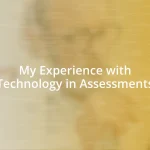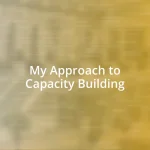Key takeaways:
- Sustainable impact measurement combines quantitative data with qualitative stories, emphasizing human experiences behind the metrics.
- Key principles include stakeholder involvement, adaptability to evolving contexts, and considering both short-term and long-term perspectives for comprehensive insights.
- Effective communication of impact should be tailored to different audiences, using narratives and visuals to enhance engagement and foster trust.

Understanding Sustainable Impact Measurement
When I first delved into sustainable impact measurement, I remember feeling overwhelmed by the vastness of the subject. It’s not just about tracking outputs; it’s about understanding how those outputs create meaningful change in communities and ecosystems. Have you ever thought about how a simple action can resonate, like a pebble creating ripples in a pond?
Sustainable impact measurement isn’t merely a process; it’s a mindset. I recall collaborating with a local nonprofit, where we designed metrics that reflected authentic community voices. It was enlightening to see how quantifying qualitative data allowed us to grasp the real essence of our efforts. Isn’t it fascinating how numbers can tell stories if we listen closely enough?
Moreover, the emotional aspect of measuring impact can’t be overstated. I once interviewed beneficiaries who shared how a small initiative transformed their lives. Their heartfelt responses reaffirmed to me that behind every statistic lies a human experience. Have you ever experienced the power of stories in data? It’s a reminder that sustainable impact measurement should always and foremost prioritize human connection and well-being.

Key Principles of Sustainable Impact
Sustainable impact hinges on several key principles that guide the measurement process. One of the foremost is stakeholder involvement. I remember organizing a workshop where community members shared their aspirations and concerns. Their input not only shaped our metrics but also fostered a sense of ownership. When stakeholders are engaged, the impact measurement feels more like a shared journey than just data collection.
Another important principle is adaptability. The landscape of social and environmental issues is ever-evolving, and so must our approaches. I learned this firsthand while working on a renewable energy project. As new technologies emerged and communities provided feedback, we adjusted our metrics accordingly. This flexibility allowed us to capture more relevant data that truly reflected the shifting dynamics on the ground.
Lastly, incorporating both short-term and long-term perspectives is crucial. During a project evaluation, I realized that focusing solely on immediate outcomes can be misleading. For instance, a training program may yield quick skills development but its true value unfolds over years as those skills empower job seekers. Balancing these perspectives ensures a fuller understanding of sustainable impact over time.
| Key Principle | Description |
|---|---|
| Stakeholder Involvement | Engaging community members to co-create metrics leads to ownership and better alignment with their needs. |
| Adaptability | Adjusting measurement approaches to reflect changes in social and environmental contexts ensures relevance and accuracy. |
| Short-term vs Long-term Perspectives | Evaluating both immediate and lasting outcomes provides a comprehensive view of sustainable impact. |

Identifying Relevant Impact Metrics
Identifying relevant impact metrics requires a thoughtful approach that combines context and stakeholder input. I recall a project where we attempted to measure educational impact, and we realized that simply counting test scores didn’t capture the full picture. It was the stories from students and teachers about lost opportunities and newfound hope that ultimately guided our metric development. If we focus solely on quantitative data, we risk overlooking the deeper, qualitative impact of our work.
To identify the most relevant metrics, consider these essential factors:
- Community Needs: Engage with community members to understand their perceptions of success and the issues they prioritize.
- Long-term Vision: Think about what you hope to achieve not just now, but in the future, and develop metrics that reflect both immediate and sustained impacts.
- Diverse Perspectives: Include voices from different stakeholder groups—beneficiaries, funders, and staff—to ensure metrics capture a holistic view of impact.
- Data Availability: Assess what data is accessible and feasible to collect; choosing metrics that can be supported with reliable data will enhance credibility.
- Alignment with Goals: Ensure that the metrics you select directly tie back to your organization’s specific goals and objectives, creating a direct line between measurement and mission.

Data Collection Methods for Impact
The choice of data collection methods is pivotal in understanding the actual impact of any initiative. For example, during a health project I managed, we employed surveys and focus groups to gather insights from participants. I found that while surveys provided quantifiable data, the focus groups unveiled rich narratives that truly highlighted the participants’ experiences. Have you ever noticed how numbers can often miss the heart of a story? Engaging directly with individuals often reveals layers of meaning that raw data simply can’t capture.
In addition to qualitative methods, employing mixed-method approaches can enhance the robustness of impact measurement. I remember utilizing both observational techniques and interviews in a community development project. This combination allowed us to observe behaviors firsthand while also understanding the motivations and challenges voiced by community members. By triangulating data sources, we painted a clearer picture of our impact. Isn’t it fascinating how blending different methods can deepen our understanding?
To ensure that data collection methods are effective, it’s essential to align them with the specific context of your project. I once faced challenges with a purely quantitative method when trying to assess the impact of a mental health program. The numbers felt cold and detached, failing to convey the emotional transformations participants experienced. By pivoting to include storytelling as part of our data collection, we were able to capture the genuine essence of our efforts. Reflecting on how we choose to collect data can spark revelations that drive the true narrative of our impact.

Analyzing Impact Data Effectively
Understanding impact data is more than just compiling numbers; it’s about discerning the stories those numbers tell. In one of my earlier projects focusing on environmental conservation, we gathered tons of data, yet it felt hollow. It wasn’t until I facilitated a workshop where participants shared their personal connections to the land that I truly understood our impact. How often do we forget that behind every data point lies a human experience?
To analyze impact data effectively, I’ve found it crucial to embrace both quantitative and qualitative insights. For instance, while statistical indicators showed a rise in community engagement in our literacy program, it was the anecdotes of individuals finally reading to their children that moved me. These stories, rooted in emotions, offered a powerful counterbalance to the cold statistics. Isn’t it essential to ensure our analyses capture the heart as much as the hard facts?
Finally, interpreting impact data is an iterative process. I’ve learned that bringing diverse voices into analysis sessions enriches our understanding. In a recent evaluation meeting, involving community members led to surprising interpretations of our findings. Their perspectives unveiled aspects of our work that had eluded the team. Why limit ourselves to our own views when those most affected can provide invaluable insights? This collaborative approach not only enhances our analysis but fosters a deeper connection with our mission.

Reporting and Communicating Impact
In my experience, effective reporting goes beyond just presenting numbers; it’s about crafting a narrative that resonates with stakeholders. I once faced the challenge of disseminating findings from a wildlife preservation project where simple data tables didn’t convey the urgency of our work. By incorporating visuals that illustrated before-and-after scenarios of the habitats we restored, our report sparked significant interest. Have you ever thought about how storytelling through visuals can transform a dry report into something that inspires action?
When it comes to communicating impact, it’s essential to tailor your message to your audience. During a project centered on youth employment, I learned the importance of framing the outcomes in a way that mattered to different stakeholders. For funders, we emphasized the economic return on investment, while for the participants, we highlighted personal growth stories. Each group connected with the data on a different level, underscoring the importance of personalized communication. Isn’t it fascinating how the same set of statistics can evoke different emotions from various audiences?
I also believe that transparency in reporting fosters trust and engagement. In a community health initiative, I was transparent about both successes and shortcomings in our impact report. By openly sharing challenges faced along the way, we not only built credibility but also encouraged community members to feel invested and share their ideas for improvement. It’s incredible how honesty can transform the perception of a project, inviting collaboration rather than criticism. What have you found makes communication more trustworthy in your experience?

Continuous Improvement in Impact Measurement
Continuous improvement in impact measurement is a journey that I’ve learned to embrace wholeheartedly. In my work on community development projects, I revisited our initial metrics after receiving unexpected feedback from participants. This prompted a realization: what started as a rigid framework could evolve into a flexible approach that truly reflected the community’s changing needs. How often do we pause to reevaluate our own indicators to ensure they remain relevant?
I find that nurturing a culture of learning within teams is key to continuous improvement. During one project evaluation, we openly discussed our failures alongside our successes. Recognizing that setbacks are part of the process transformed our perspective; instead of fearing criticism, we started celebrating it as an opportunity for growth. It made me wonder, how powerful could our impact become if we shift our mindset to view failures as stepping stones rather than barriers?
Lastly, integrating technology into our measurement practices has been a game changer. In a recent initiative, we utilized mobile apps to gather real-time feedback, allowing us to adjust our strategies on-the-fly. I was surprised at how immediate data collection not only quickened our response time but empowered participants to take ownership of their experiences. Isn’t it fascinating how technology can bridge gaps, making our measurement processes more dynamic and inclusive?















